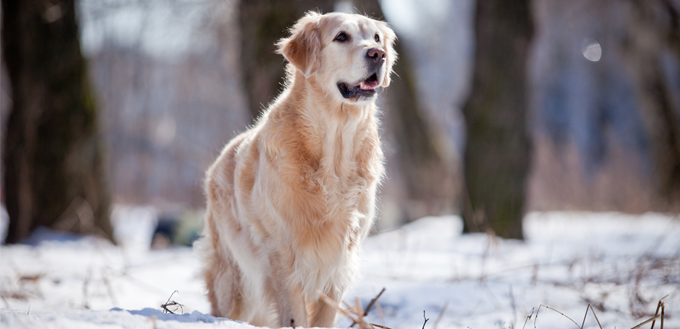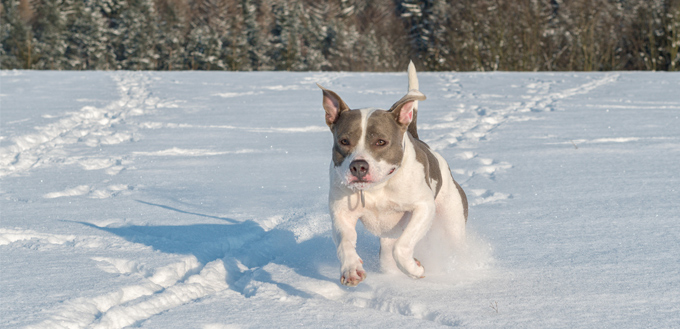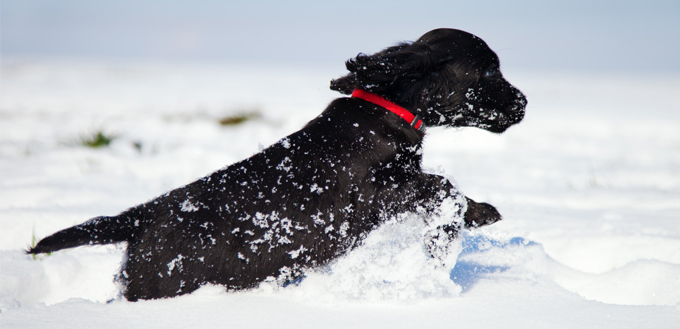Winter means holiday, joy, and celebration. Christmas, New Year, snowfall – we humans have many reasons to feel happy this season. Our canine friends, on the other hand, need some extra attention in winter to stay fit.
You can get them with some dog boots and dog houses for winter to ensure their good health this season. However, that might not be enough for these canine animals to stay out of many health hazards. That is why here we discuss five of the most common winter health hazards for dogs and possible ways of preventing them.
Related Post: Best Christmas Presents for Dogs

Frostbite
Frostbite is pretty much like the cold weather biting on your pet’s peripheral parts like its tail, ears, and toes. These particular areas tend to get frozen as a result of frostbites. This is the preliminary condition before hypothermia strikes. Even if frostbite itself is not fatal, it can lead to other diseases that are fatal. Another name for frostbites is congelatio according to medical jargon.
Symptoms
The most common symptom of a frostbite attack is the discoloration of your dog’s skin. This happens because the blood flow in its body decreases in extremely low temperatures. As a result, the skin can grow very pale including some bluish-white areas. Along with such discoloration, the skin may also show some frosts formed around the peripheral regions. Touching such affected areas can cause pain for your dog.
When you go back to a warmer or more comfortable area, the fade areas suddenly turn red and swollen. This horror can transform into skin ulcer or blistering. If treatment is not provided, the local tissues in those regions die and slowly turn black.
Potential Causes
It is highly unlikely that a pet with a careful master would fall victim to frostbites. That is because frostbites attack the dogs who stay outside in cold for a long time. Frequent contact with cold water can make the whole ordeal even worse for them.
In such conditions, the dog’s body automatically narrows down the blood vessels so that all organs can continue their functions. If the body needs to do so for a long time, the blood will ultimately stop reaching certain areas causing them to suffer from frostbites.
Possible Treatment
If you have spotted frostbite symptoms in your dog, there are some things you can do to alleviate its sufferings a little. Firstly, use either a radiator or a dryer to warm up a small piece of towel. Then gently apply it to affected regions of the dog’s body so that they reach an optimum temperature between 100°F and 108°F. This may provide it with some temporary relief but for a permanent solution, take the dog to a reliable vet.
Preventive Measures
Since long exposure to cold is the main reason behind frostbites, make sure your pet is feeling warm enough in cold surroundings. Put some comfortable dog garments on it like dog sweaters, coats for dogs, boots, dog jackets, etc. This is a vital step if your dog already suffers from a physical condition like heart diseases or diabetes which hampers blood flow.
Hypothermia
Hypothermia arises from the dog’s body reaching unusually low temperatures. It can attack in three levels according to the body temperatures – mild (90-99°F), moderate (82-90°F), and severe (less than 82°F). All these temperatures are way beyond the normal range for a dog. Such conditions can lead to damages in the central nervous system, respiration, heart, blood flow, and immunity.
Symptoms
The symptoms of hypothermia change with the severity levels. When it is at mild state, your dog will seem fatigued, trembling, and unable to focus. If it reaches the moderate level, the muscles can get stiffer, along with low blood pressure and slowed down breathing. The most extreme level of hypothermia exhibits dilated pupils, difficulty in breathing, and faint heartbeat. Sometimes, the affected dog can even get into a coma from severe hypothermia.
Potential Causes
Similar to frostbites, the main cause behind hypothermia attacks is also a cold surrounding. Long exposure to such surroundings can trigger hypothermia in dogs. The newborn puppies may also suffer from hypothermia in room temperatures since their bodies can lose heat at a faster rate. Ultimately, puppies, old dogs, and the ones on anesthesia are the most susceptible to hypothermia.
Hypothermia can also affect the dogs who are already suffering from a neurological disease called hypothalamus or a condition called hypothyroidism. In the hypothalamus, the part of its brain dealing with the control of body temperature is hampered. On the other hand, a reduced amount of thyroid hormones cause hypothyroidism.
Possible Treatment
Once your pet is diagnosed with hypothermia, you should minimize its movements in order to reduce the possibility of any more heat loss. This will also lower the possibility of a subsequent attack by cardiac arrhythmia where the heart pumps at highly irregular beats.
Warm up the dog as soon as possible with comfortable garments like the dog boots and dog sweaters. For moderate hypothermia, you can also use heating pads for this purpose. Don’t be alarmed if you see the body temperature drop at the beginning of this process. It is a natural reaction to the warm blood inside the dog’s body reacting to the thermal change of its exterior.
Severe hypothermia will require breathing aids and IV fluids to deal with the complex condition.
Preventive Measures
Don’t let your pet stay out in the cold for a long time to avoid hypothermia. You can also consider making some warm renovations to the dog houses for winter, maybe even add some heated pet beds, or dog house heaters. The most vulnerable patients to hypothermia include dogs with hypothalamic disease, hypothyroidism, low body fat, anesthesia, or previous surgery, as well as puppies and old dogs.

Antifreeze
It is a very common problem for pet owners where their canine companions lick off antifreeze. The chemicals within an antifreeze are harmful to the dogs, particularly the puppies. Only a few licks can take them to fatal conditions. In the very least, it can cause them to behave like a drunk and can then lead to fainting or seizures.
Symptoms
As we just mentioned above, drunk behavior is one of the common symptoms of antifreeze. Such behavior includes unstable movement and euphoria. There are more conspicuous symptoms like vomiting, diarrhea, excessive urination, seizures, and fainting. The dog can also seem to be fatigued and depressed. In extreme stages, antifreeze can also put it in a coma.
Potential Causes
If you are one of those pet owners who often take your dog out with you in the car, you need to be a little extra careful this winter. The antifreeze on your car’s radiator can drip off to the floor, which can later be ingested by the pet. Besides, its chemicals are also available in toilet bowls where the pipes are on antifreeze. Its main element named ethylene glycol is dangerous for these canine beings. An amount as small as 88ml of antifreeze can be fatal for an average sized dog.
Possible Treatment
If you detect the dog ingesting antifreeze around you, try to make the pet vomit it out immediately by providing hydrogen peroxide solution. The ideal amount of this solution is one teaspoon for every 5 lbs of the dog’s weight. If your dog is very heavy, give him the ideal amount of this solution a maximum of 3 times at 10-minute intervals.
This treatment can work only within two hours of its ingestion of antifreeze. To take a safer route, take the pet to your trusted vet before inducing the vomit. Do not go for this approach if your dog is suffering from shock, distress, breathing issues or is fainted. A vet can later provide it with necessary antidotes for canceling the poisonous effects.
Preventive Measures
Make sure the pets never get to reach or access the antifreeze containers, no matter where they are – the car or the house. After they run out, get rid of them properly so that they stay away from your pet’s attention. If you mistakenly spill the antifreeze, keep all your pets away from that area for a while and clean it up immediately. Keep your car’s radiator in regular checks to avoid any leaks. If you still find one, repair it as soon as possible.
Ice Melts
Ice melts are used to clear up all the ice accumulated on sidewalks disrupting the regular movement of citizens. While they do make life easier for us humans, they are not so helpful for our pets’ health. They can irritate your dog’s paws and prove to be even more harmful on ingestion. If it eats up ice melts in a trivial amount like less than one ounce for every 2.3 lbs of its weight, there can still be fatal consequences of that ingestion.
Symptoms
The most common symptom of being affected by ice melts is the pet getting irritated on its paws. Besides, if the dog happens to lick it off the ground, symptoms like vomiting or diarrhea may also occur. This can also happen if it licks the uncleaned paws after getting back home. Other possible symptoms include low blood pressure, tremors, seizures, fatigue, excess thirst and excess salivation.
Potential Causes
The ice melts generally compose of sodium chloride, calcium chloride or potassium chloride. All of these chemicals tend to irritate or burn the skin of our canine companions’ paws. Ingesting them upsets the gastrointestinal system of dogs, resulting in possible kidney failure and even death.
Possible Treatment
If you have handled such situations before, give the dog appropriate medications to cancel out the toxicity. You can use activated charcoal to absorb the poison before it enters the bloodstream and to prevent it from getting into the pet’s stomach.
Preventive Measures
Every time you finish a walk with your cute pet, clean its paws immediately after returning home. This applies on all occasions including the ones where you don’t see any ice melt on street. The substances may still exist in the area and it is better to be safe than sorry. An easier solution would be to buy the pet a pair of dog boots to keep its paws from touching the ice melts. Additionally, don’t let your pet drink from the puddles or eat snow anywhere. If you need to use ice melts for your personal use, make sure to choose a non-toxic brand.
Related Post: Best Dog Paw Washer

Seasonal Allergies
The season of winter itself can bring in some allergies with its cold weather and changing environment.
Symptoms
The possible symptoms of winter allergies include itchy or watery eyes, running nose, coughing, sneezing, dark under-eyes, and itchy or irritated skin.
Potential Causes
Winter allergies for your dog can result from coming in contact with dust mites, mold, and other similar allergens. It can also occur from just the seasonal dry air with very low humidity.
Possible Treatment
Give your dog a good bath with a reliable, calming, moisturizing, and hypoallergenic shampoo to get rid of all allergens. However, don’t bath it too often since that can dry out the skin. There are also medications available for dealing with dog winter allergies. Invest in some of them upon your vet’s suggestions.
Preventive Measures
To prevent future winter allergies, clean up the furnace filter, and humidifier of your home on a regular basis. Maintain the indoor humidity at below 40% to keep the dogs warm.
Keep your canine friend inside the house as long as possible in winter. Take him out only for quick walks after he has put on his dog boots and other essential winter items. Avoid the frozen areas where the surface may not be able to handle your pet’s weight. Their slippery texture is also not safe for the dogs. By maintaining optimum temperature and humidity indoors, you can make the winter a happy season for your pet.
Sources:
- Is Your Dog Ready for Winter?, PetMD
- Five Ways To Protect Pets In Winter, The Humane Society of the United States
- Cold Weather Safety Tips, The ASPCA
- How to Keep Dogs Warm in the Winter, Best Friends Animal Society







